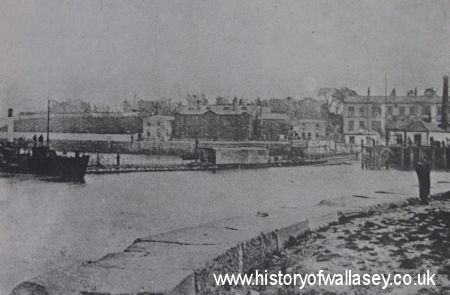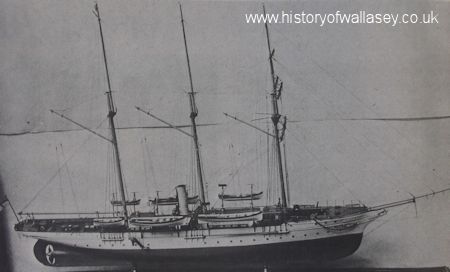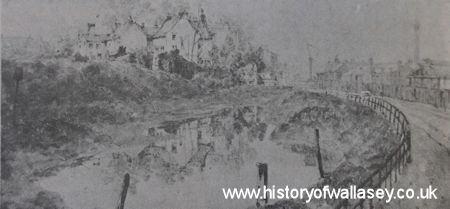The Sunbeam, the yacht that sailed the world and about which books were written. The paddle-steamer Kathleen Mavoureen. Sleek beauties of boats. Workaday barges and cutters. Seacombe made them all in the old days, the days when there were slipways from East Street into the Mersey, the days when local launchings were occasions for the flying of flags, and the granting of special holidays for children at school. The boat-builders came to town full of high hopes, did much that was fine and memorable, and then, quite suddenly, closed their yards for ever, left them to tumble and decay, become overgrown with grass and moss.
The shipyards came with the building of the docks in Wallasey Pool just over 150 years ago. They were centred along the river front south of Seacombe to Alfred Dock entrance.
On land on the river side of East Street a number of boat builders set up between the 1860’s and 1880’s.
They had no separate jetties, like the old slipways at Cammell Laird’s, but had a continuous high quay wall, built of great sandstone blocks.
At high water spring tides came over the top of the wall, enabling the ships to be launched.
Among the first of the shipbuilders were Bowdler and Chaffer. They were established in 1864.
Andrews and Company came shortly after, followed by Thomas Vernon's & Sons, Alexander Jack, and J.F. Waddington & Co.
They came because the spread of the dock system in Liverpool had displaced them from that side of the Mersey.
Bowdler & Chaffer’s, close to Seacombe Ferry, had a frontage of 250 feet. They boasted three slipways.
 |
Seacombe Ferry in the 1870's. A jetty ran out to the boats. In the background to the right is Stoke's Hotel, near to the site of which the old Seacombe Ferry Hotel once stood. To the left of the picture lay the old shipyards |
Just to the south of them were James Andrews and Company. Theirs was a small yard with a river frontage of just over one hundred feet.
Vernon’s had the land from Andrew’s to Alfred Dock entrance, with a river frontage of 450 feet. Alexander Jack took over Vernon’s yard in 1883.
The Seacombe of the time was exactly like the Poulton, Wallasey Village and Liscard of the time – just a village. Small cottages with big gardens. Here and there terraces of houses. A few small pubs.
There was one main street, Victoria (now Borough) Road. There were lanes and dells, and little wooded copses.
Paddle-driven boats piled between Seacombe and Liverpool. They had names like ‘Wild Rose’, ‘Heatherbell’, and ‘Sunflower’ – also known as ‘Soup Plate’ because of her peculiar shape.
Seacombe had a handful of other industries. There was a smalt works, the Phospho Peruvian Guano Works, a small brewery, and John Goodwin’s pottery.
Belle Vue Road and all between that and what is now Borough Road was occupied by Belle Vue Tea and Pleasure Gardens.
Oakdale Road was a dale. North from the top of Borough Road fields stretched away uninterruptedly towards Liscard.
There were black spots, small hovels of houses. There was poverty.
Records show that more than half the population of the area could neither read nor write. Drunkenness was a serious problem.
The early shipyards supplied something urgently needed – employment for the locals, an opportunity for them to do something useful.
In their first year of operation Bowdler & Chaffer launched four ships. They built up a flourishing business and made a great name, supplying vessels to many famous Liverpool shipowners.
The best – certainly the most famous – of the Seacombe-built boats was the yacht ‘Sunbeam’. She was a beauty of a craft.
‘Sunbeam’ became known all over the world. She sailed round the greater part of it.
She was built for Lord Brassey (1836-1918) and launched in 1874 – “a showpiece of the boat-builders craft”.
Whilst Civil Lord of the Admiralty in the 1880’s, Lord Brassey used the yacht to visit many overseas countries.
His first wife, Anna, published in 1878 her diaries under the title of ‘A Voyage in the Sunbeam’. The book ran through many English editions and became an international bestseller.
 |
The Sunbeam |
In January, 1872, a fire at Bowdler & Chaffer’s yard caused extensive damage. The firm was just recovering from it when a disastrous strike of shipwrights made it decide to give up the business.
Ships still on the stocks were finished, and although a few more were built by another under Bowdler & Chaffer’s supervision, the yard finished work and was never re-opened.
The Andrews firm lasted for just one year. It opened a yard in 1865, completed two or three vessels, and closed in 1866.
Thomas Vernon’s got under way in 1865 and launched their first ship a year later. They closed in 1869.
For about four years after 1879 there was no boat-building at all in Seacombe, but the industry recommenced on Vernon’s old site early in 1883.
Alexander Jack established a yard occupying 44,000 square yards. He spent £20,000 fitting it out.
Jack built two vessels for the Queensland Government – one was lost on her way there – and the paddle-steamer ‘Kathleen Mavourneen’, which ran for many years between Liverpool and Drogheda.
Labour troubles hit the firm badly in the 1880’s. Eventually it went bankrupt.
 |
This was the road from the docks to Seacombe Ferry in the 1860s. The entrance to the old shipyards lay to the right of the picture. Back centre of the picture was where the Marine Hotel (Brassey's) once stood. |
The last of the local shipyards was Waddington’s. In June, 1866, they took over the yard vacated by Andrews and Company.
Waddington was a man ahead of his time. He designed and built a submarine – or rather, a vessel something like one.
He called it the ‘Porpoise’. He failed to persuade the Royal Navy to take any notice.
The Porpoise, the futuristic craft nobody wanted, was anchored for nearly two years a little below high water mark opposite Marine Terrace. Finally she was broken up there.
The year 1887 marked the end of boatbuilding at Seacombe. Waddington went bankrupt.
No other craftsman followed him. It was the end of a chapter.
It had flowered and then quickly died, the industry that came to Seacombe of over one hundred and fifty years ago.
The old shipwrights built fine craft and made themselves a first-class reputation. In the 1870’s and 1880’s they were men to be reckoned with.
But the big yards of other places killed them. The big yards took over the market with their mechanisation and new ways.
Ships slid off the stocks at Seacombe for a total of only twenty years. It was a short lived industry, and yet it helped put Wallasey on the map and played an important part in the pattern of its development.
What John Goodwin had started with his Seacombe pottery in the 1850’s – a tradition of craftsmanship, a pride in work – the shipbuilders strengthened.
Featured sites
- Non Gamstop Casinos
- Casino Not On Gamstop
- UK Casinos Not On Gamstop
- Non Gamstop Casinos UK
- Sites Not On Gamstop
- Sites Not On Gamstop
- Casinos Not On Gamstop
- Casinos Not On Gamstop
- Casinos Not On Gamstop
- Non Gamstop Casino UK
- Casinos Not On Gamstop
- Non Gamstop Casino
- UK Online Casinos Not On Gamstop
- UK Online Casinos Not On Gamstop
- Non Gamstop Casinos
- Casino Sites Not On Gamstop
- Casinos Not On Gamstop
- Casinos Not On Gamstop
- Best Betting Sites
- Casinos Not On Gamstop
- Gambling Sites Not On Gamstop
- Betting Sites That Are Not On Gamstop
- Non Gamstop Casinos UK
- UK Online Casinos Not On Gamstop